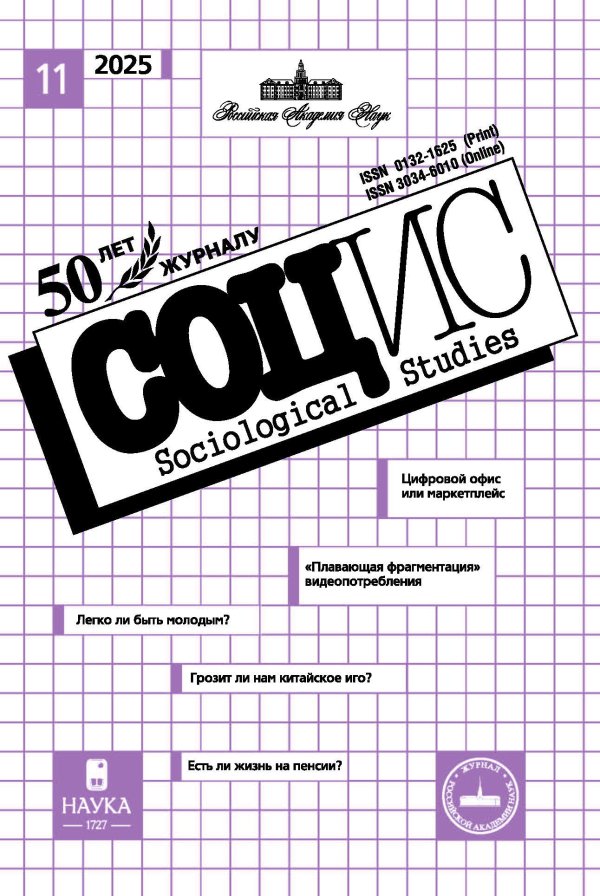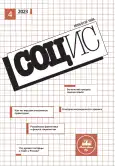Contours of the Migration Crisis of 2020–2022 in Russia
- Authors: Shustov A.V.1
-
Affiliations:
- P. G. Demidov Yaroslavl State University
- Issue: No 4 (2023)
- Pages: 51-64
- Section: Articles
- URL: https://journals.rcsi.science/0132-1625/article/view/141282
- DOI: https://doi.org/10.31857/S013216250023213-7
- ID: 141282
Full Text
Abstract
Keywords
About the authors
Alexander Vladimirovich Shustov
P. G. Demidov Yaroslavl State UniversityYaroslavl, Russia
References
- Авдашкин А. А. Среднеазиатские и китайские мигранты в ракурсе общественного мнения: уральские и сибирские кейсы // Социологические исследования. 2022. № 8. С. 47–58.
- Аршин К. В. Риски кризисной миграции из стран Центральной Азии в Россию // Гуманитарные науки. Вестник Финансового университета. 2021. T.11. №1. С. 58–65.
- Варшавер Е., Иванова Е., Рочева А. Положение мигрантов в России во время пандемии коронавируса (COVID-19): результаты опроса // Группа исследований миграции и этничности. URL: http://mer-center.ru/_ld/1/169_06-07-2020-vars.pdf (дата обращения: 19.07.2022).
- Гончарова Н. П., Ноянзина О. Е., Максимова С. Г. Миграционные процессы: угроза или условие демографической безопасности Алтайского края? (экспертная оценка риска демографического кризиса в регионе) // Известия Алтайского государственного университета. 2013. № 2. Т. 2. С. 226–229.
- Денисенко М.Б., Мукомель В.И. Коронавирус и трудовая миграция // Аналитический бюллетень НИУ ВШЭ об экономических и социальных последствиях коронавируса в России и в мире. 26.06.2020а. № 7. URL: https://www.hse.ru/data/2020/06/25/1607268420/HSE_Covid_07_2020_2_2.pdf (дата обращения: 19.07.2022).
- Денисенко М.Б., Мукомель В.И. Трудовая миграция в России в период коронавирусной пандемии // Демографическое обозрение. 2020б. Т.7. №3. С. 84–107. doi: 10.17323/demreview.v7i3.11637.
- Космарская Н.П. «Коррупция», «толпы» и «лезгинка»: региональная специфика отношения россиян к мигрантам (на примере Москвы и Краснодара) // Журнал социологии и социальной антропологии. 2018. Т. 21. №2. С. 187–213.
- Куликова С.Н. Миграционные процессы в России в условиях кризиса (реферативный обзор) // Экономические и социальные проблемы России. 2010. №1. С. 141–157.
- Миграция и безопасность в России. М.: Интердиалект+, 2000.
- Мкртчян Н.В., Флоринская Ю.Ф. Миграция в Россию: самый низкий уровень за десятилетие // Экономическое развитие России. Т. 28. №1. Январь 2021 г. С. 50–54.
- Мукомель В.И. Среднеазиатские мигранты на российском рынке труда: до пандемии // Социологические исследования. 2022. № 1. С. 63–75.
- Новожилова С.С. Предпосылки развития миграционного кризиса в России // Проблемы экономики, организации и управления в России и мире. Материалы XII международной научно-практической конференции (7 октября 2016 года). Прага, 2016. C. 105–106.
- Общественное мнение – 2021. М.: Левада-Центр, 2022.
- Омельченко Д.А., Максимова С.Г., Молодикова И.Н. Риски международной миграции и политика интеграции в азиатском приграничье России (по данным социологического исследования в Алтайском крае) // Society and Security Insights. 2018. Т. 1. №3. С. 53–77.
- Рязанцев С. В., Молодикова И.Н., Брагин А.Д. Влияние пандемии COVID-19 на положение мигрантов на рынках труда СНГ // Балтийский регион. 2020. Т. 12. №4. С. 10–38. doi: 10.5922/2079-8555-2020-4-2
- Рязанцев С.В. Миграционный кризис: понятие и критерии // Демис. Демографические исследования. 2021. Т. 1. № 1. С. 7–16. doi: 10.19181/demis.2021.1.1.1
- Banulescu-Bogdan N., Fratzke S. Europe’s Migration Crisis in Context: Why Now and What Next // Migration Policy Institute. 24.09.2015. URL: https://www.migrationpolicy.org/article/europe’s-migration-crisis-context-why-now-and-what-next (дата обращения: 23.07.2022).
- Buonanno L. The European Migration Crisis // Dinan, N. Nugent, W. E. Patterson (eds). The European Union in Crisis London: Palgrave Macmillan, 2017. P. 100–130.
- Estevens J. Migration crisis in the EU: developing a framework for analysis of national security and defence strategies // Comparative Migration Studies. 2018. №28. https://doi.org/10.1186/s40878-018-0093-3 (дата обращения: 23.07.2022).
- Nirenstein F. The Immigration Crisis in Europe // The Migration Wave into Europe. An Existential Dilemma. Jerusalem Center for Public Affairs. 2019. URL: https://jcpa.org/pdf/Fiamma_migration_31mar2019_web_covers.pdf (дата обращения: 23.07.2022).










